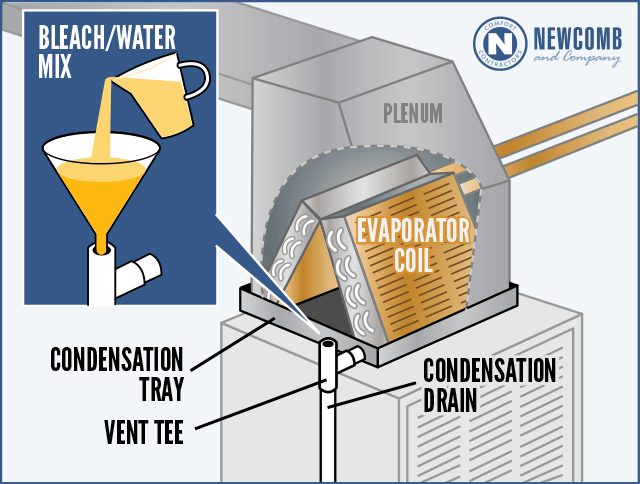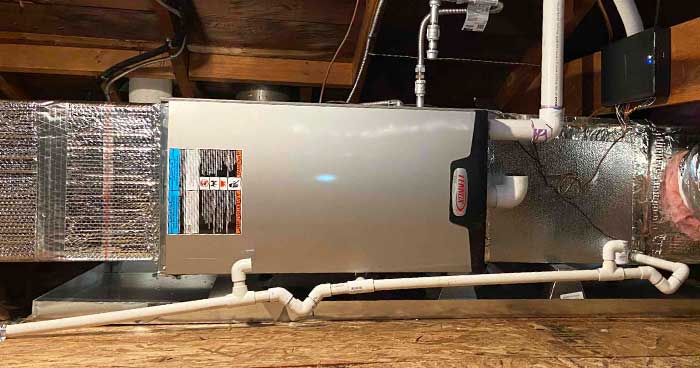How does Condensate Drain Pan Work-Although a condensate drain pipe is a vital component of your HVAC system, most people are unaware of its existence? Your home and HVAC system are well-protected by this tiny tray from water damage, mould growth, and even early system failure.
What is a Condensate Drain Pan?
In addition to controlling the temperature in your home, an air conditioner also prevents your home from being overly humid. Again, it is because it removes condensation from the atmosphere. An air conditioner can produce 5 to 20 litres of condensate every day.
Thanks to the condensate drain pan, all that water has a way out. The pan is inside the furnace, directly below the evaporator coil.
 The evaporator is filled with extremely cold refrigerant as it cools your air. However, an atmosphere loses heat due to a sudden drop in temperature, and a lot of condensation is bent. Think about a cool glass of water on a hot day.
The evaporator is filled with extremely cold refrigerant as it cools your air. However, an atmosphere loses heat due to a sudden drop in temperature, and a lot of condensation is bent. Think about a cool glass of water on a hot day.
Must drain condensation produced during the cooling cycle because it is in such large amounts. It is not possible. It can’t evaporate quickly enough. As the drain pan fills with condensation, excess water goes into a drainage tube.
What is a Condensate Drain?
It would help you learn more about a condensate drain and its significance—a condensate drain of various components. The indoor unit’s evaporator coils’ drain pan is the first thing to notice. The pipe is the next factor. From the pan, water flows into the line. Once inside the tube, the water passes through it before exiting to the outside.
Most condensate drains pass through an exterior wall, protecting your house from water harm. Depending on your drain configuration, you might also have a condensate pump. The pump’s job is to move water through the pipes. In some situations, gravity can accomplish the job without needing a pump.

Your air filters do more than remove airborne dirt—both the efficiency of your HVAC system and your health impacts. HVAC systems work harder to heat your home if your filters clog with debris. In addition, higher energy bills and increased system wear and tear result from the more energy required to move air.
This system has some flaws despite being straightforward. Your drain may become clogged with trash or algae. Water can no longer flow through the pipes when the blockage is too big. The water accumulates in your drain pan since it has nowhere else to go and causes issues.
Taking Care of Your Drain Lines How does Condensate Drain Pan Work
You might choose to be proactive rather than deal with a clogged drain. For example, you might be able to avoid drain line clogs by doing routine maintenance.

The specialist will thoroughly inspect your HVAC system during a maintenance visit. It also applies to the condensate drain. The expert can unblock the pipe if there are any indications of a blockage. They can also look for damage or wear on your condensate pump.
It’s important to note that your condenser drain can stop working for reasons other than clogs. For example, the water might not flow through the pipes effectively if an HVAC installer installed the drain improperly. Therefore, the necessity for a may arise.
What Happens When You Don’t Have a Drain?
You will experience issues if your condensate drain isn’t functioning correctly. First, there is the problem of water damage. The evaporator coils’ condensation will drop into a drain pan. However, the water will eventually spill out onto the floor because there is no drain.
The water then has the potential to result in water damage. The water not only runs your floors but also endangers anyone who passes by. Make sure the water has a place to drain to prevent a slip-and-fall catastrophe.
Mould development is another problem caused by the wet floor. Mould grows best in moist settings. Unfortunately, due to your leaky AC, you can wind up having to pay thousands of dollars to remove mould.
NO AC
Lack of cool air is one of the most harmful effects of no drainage. If your system is more recent, it most likely has a failsafe switch next to the drain pan. The failsafe turn your air conditioner off if the pan fills up too much. As a result, no chilly air will be present until the pan drain.
Removing the water from the drain pan would seem like a simple solution. Unfortunately, removing the water won’t work for very long, even though it can cause your AC to restart. You might have to go to the pan and get the water every few minutes.
LESS EFFICIENCY
The effectiveness of your system is also affected by your lack of drainage. For example, an air conditioner uses electricity when it continuously turns on and off. Therefore, the system must also exert more effort.
A functional condensate drain is necessary for an efficient air conditioner. High energy expenses could be the outcome of inefficient operation. Even worse, it harms your HVAC system. Your air conditioner may work harder than necessary, resulting in a shorter lifespan. You could need to replace it in a few years.
Your refrigerant-based air conditioning system doesn’t use water to cool the air; swamp coolers do that. However, water moisture produces when a cold refrigerant evaporates in the air conditioner’s indoor coils. As a result, the sound of water dripping inside your air conditioner is normal and occurs during the cooling process of your home. The air conditioner eliminates the moisture that accumulates.
The condensate pan and drain to get rid of this moisture. We’ll investigate this part of your air conditioner because you may need air conditioning service if it has issues.
The Purpose of Condensate Drain and How does Condensate Drain Pan Work
When the AC runs, moisture accumulates because the excellent coils induce airborne water droplets to condense on their surface. A similar thing happens when you remove a cold beverage can from the refrigerator: as heat from the outside begins to enter the cold can, moisture in the water condenses into droplets along the surface. The coils function similarly, except that the cool refrigerant in the waves absorbs the heat and reduces condensation.
These water specks need transports somewhere. Suppose they correctly remove it from the AC cabinet. In that case, it can lead to several issues, including water damage to your home, harm to the air conditioner, and the creation of the ideal condition for the growth of mould, mildew, and other organisms in both the house and the air conditioner.
Where is the condensate drain pan located?
The evaporator coil locates below the condensate drain pan. All of this is in the furnace. Usually, an evaporator coil is located just before the air filter.
Through supply vents, indoor air draw into the buildings, through the HVAC system, and onto the evaporator coil. After being cooled and passing through an air filter, the air circulates throughout your house.
The placement of the pan will vary depending on how your AC sets up:
Installing or using a vertical furnace
Commonly installed in garages or utility closets, these upright furnaces are visible. These types have the evaporator coil right below the loop, and the drain pan is above the stove.
installing or using a horizontal furnace
A horizontal installation, or is on its side, is standard for a furnace in an attic. The evaporator coil and condensate drain pan locate here next to and below the stove, respectively. A second drain pan frequently initiates on horizontal furnaces.
What else damages the condensate drain pan?
We have already discussed the possibility of rust and corrosion leading to the failure of metal condensate drain pans. Unfortunately, due to the furnace’s heated air, even the plastic drain pans suffer damage throughout the winter.
When the heating cycle runs, warm air uses to wash the drain pan while it’s chilly outside. However, any moisture in the pan can remove by direct heat, which could result in leaks and cracks.
Any cracks may jeopardise condensate drain pan security. In addition, cracks cause water leaks, which can cause water to collect at the base of the evaporator coil and perhaps in other furnace components.
Additionally susceptible to blockage is the pan’s drain line. Water cannot drain when this occurs; instead, it flows all over the HVAC system.
When your air filter is unclean, this typically occurs. The air filter fulfils two crucial functions. First, it keeps dirt and other particles out of the air you breathe and the HVAC system.
A clogged filter can’t effectively block the contaminants in indoor air that can clog your drain pan’s waste line.
You cannot store a lot of water in the condensate drain pan. It is future to fill with moving water, not stagnant water.
A number of unwelcome problems might result from a clogged condensate line, a damaged condensate drain pan, or a wet furnace. Among them are:
- Microbiological growth
- Safety hazards
- Low indoor air quality
- Internal buildup
- AC repairs
- Higher energy expenditure
- Smelly air
- Water damage to the home
Conclusion:
Your home’s health and safety, as well as the health of your HVAC system, may be seriously jeo pardise, How does Condensate Drain Pan Work if water collects anywhere in it. Get in touch with an HVAC expert immediately if you have any suspicions.
Also read: How to Prevent Bugs From Coming Through the Air Conditioner








GIPHY App Key not set. Please check settings